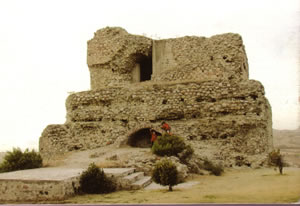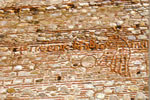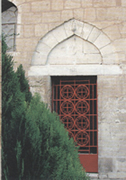BYZANTINE AND POST-BYZANTINE
MONUMENTS IN THE CITY
AGIOI ANARGYROI
 |
To the north of the city and ".below Liokalis.is the quarter known by the Christians as Katakonoz, and the exquisite church of the Agioi Anargiroi.". The area is named after the famous Byzantine lord who was later to become the Emperor Kantakouzinos, and the church is built on the site of what was, before 1310, ".the monastic dependency in Serres of the Holy and miracle-working Anargiroi of the Holy Monastery of the Ibiroi". The current church was built in 1817 and renovated in 1867.The church's frescoes are worthy of note, and their inscriptions - along with the dedications on the icons on the rood screen - are of great historical value, bearing witness, as they do, to the apogee of the city's guilds.
THE CASTLE
 |
One of the most remarkable monuments of Serbian rule in Macedonia can be found high up on the south-western section of Serres' acropolis. It is the only building worthy of note that remains of the much fought-over fortress that once crowned the acropolis.Serres Castle was the stronghold of Byzantine emperors during their campaigns against neighbouring peoples. In 1018, its walls and other fortifications were strengthened and improved on by Basil II, the Emperor of Byzantium.In 1205, the city walls and the acropolis were razed to the ground by Ioannitsis the Bulgarian. The acropolis was rebuilt in 1208, and between then and the city's occupation by the Turks in 1383, various improvements were made to the city's fortifications by the commanders and lords of the city.
 |
The one remaining tower of the castle is known as Orestes' Tower, and was built in 1350 by - as its inscription says - "Orestes for Stephanos his King" - in all probability a reference to Stephanos Dousan, the King of Serbia.The acropolis - known to the Turks as "Bas Kule", which means "The tower on high" or the "Kulas", by which name we find it referred to in the Codex of the Monastery of the Timios Prodromos - was inhabited between 1332 and 1617. In 1668 we find it in ruins according to both the Turk, Evligia Tselebi, and the French traveller, Robert de Dreux.Visitors to the acropolis of Serres can enjoy a panoramic view of the city and the fertile plain surrounding it from the walls that were once so fiercely fought over.
THE PANAGIA "LIOKALI"
 |
This small church in the north-eastern suburbs of the city of Serres has lent its name to the surrounding area. It was built in 1951 on top of the ruins of the once thriving Stavropegic Monastery of the Virgin of the Iliokallou. The church of the Virgin of the Iliokallou is first mentioned in 1323. In 1326 it is mentioned in a monasterial document as a dependency of the Philotheou Monastery. From 1477 on, it belonged to the Holy Monastery of the Eikosifoinissis.The history of the monastery is connected with the martyrdom of Neomartyras Nikitas, who arrived here from Mount Athos in March 1808 and stayed in the Church of the Virgin of the Iliokallou where he was martyred for his faith on Easter Saturday, April 4, 1808. The dependency of the Virgin of the Liokalis - as the people of Serres call it - also played its part in the 1821 revolution. In that year, Konstantinos Kasomoulis fortified the monastery of the Iliokallou with a view to using it as the headquarters for the freedom fighters of 1821.The church was burnt to the ground by the Bulgarians in 1913 after they had stolen its exceptional relics.
AGIOI THEODOROI
"Among the many temples, it bejewels, honours and makes the city of Serres known to all, no less so than the other temples. (It is) a holy and sacred place to wonder and marvel at, built in honour of those saints whose name means "Gift of God'" Theodoros Pediasimos, Man of Letters and Fourteenth Century Citizen of Serres.
The church of the gloriously martyred soldier saints, the Theodoron is located in the centre of the old city of Serres. Its large square basilica (internal dimensions 15.6 by 24 metres) is divided into two parts, the portico and the main body of the church, which is itself separated by two lines of columns into three naves. The large amount of early Christian masonry that was reused in the building of the church would indicate that it was built as early as the 6th Century.The exquisite church has been renovated on a number of occasions. No information is available on the history of the monument until the Fifteenth Century. However, the manner in which the church was built, and its final form in particular, are the result of a number of bold, easily distinguished, major alterations made at different periods down the ages. The materials and methods used by the craftsman for each of these alterations have helped most of the reputable scholars who have researched the church's history to draw roughly the same fundamental conclusions as to its architecture and decoration.
 |
It was Basil II, the Emperor of Byzantium, who ordered the first alterations to be made to the church in thanks for an unexpected victory over the Bulgarians, won not far from Serres on July 29, 1014. The church's original design - that of a basilica with traverse aisle - was altered. The church was crowned with a dome and the side wings of the traverse aisle were extended to form a three-aisled basilica. Inscriptions bear witness to the fact that the church was dedicated to Saint Theodoros the Victorious - and him alone - during the Eleventh and Twelfth Centuries.The church was destroyed, along with the whole of Serres, in 1205 by the Bulgarians under Ioannitsis. Aggelos Komnenos, the Despot of Epirus, captured the city in 1221, and repaired the church in thanks for his great victory over the Franks - led by Robert II, the Latin Emperor of Constantinople - which made his later conquest of Thessaloniki possible. He also beautified the church with magnificent mosaics - adding to the mosaics with which the church had gradually been decorated starting in the last quarter of the Eleventh Century - as an expression of gratitude towards its patron saints.In 1255, Theodore II Lascaris, the Emperor of Nicaea, gilded the church's icons with gold and silver in repayment for the divine assistance he had received from the Agion Theodoron during his army's conquest of Meleniko. From then on, small-scale work was periodically done on the church to keep the ravages of time at bay. The church was ransacked by the Turks in 1571, and suffered a great of damage from a fire in 1849. On June 29, 1913, the church was completely destroyed, along with the rest of the city, by the Bulgarians.
Rebuilding started in 1938 under Theodoros Orlando, and was completed by E. Stikas in 1959. The monument's future was under threat from natural decay, but the church was repaired thanks to intervention on the part of the Bishop of Serres and Nigrita, and once more took its place in the spiritual life of the city as a place of worship.
Continue...
